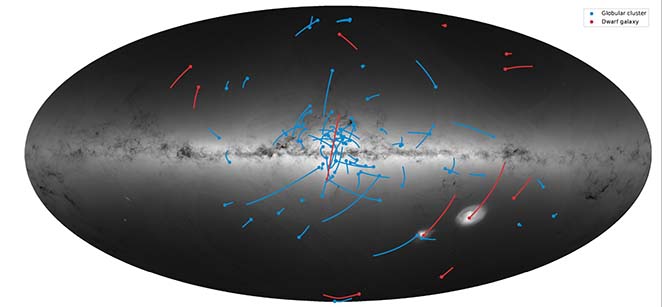New data release sparks astronomy revolution
The second data release of the European Gaia mission, which aims to make the largest, most precise three-dimensional map ever of our own and neighbouring satellite galaxies, will have an impact on astronomy across the board, from the Solar System to dark matter and cosmological models. That is the opinion of University of Groningen astronomy professor Amina Helmi, who was involved in the quality assessment for the release. Helmi is also lead author of one of six papers describing the quality of the data and the first tentative results, which were published alongside the data release on Wednesday 25 April.
‘This new data set is fabulous, really spectacular’, says Helmi with a big smile. ‘The jump in both quantity and quality is enormous. New missions will typically give you a 10- to 50-fold increase, but for this data release it’s more like 100- to 1000-fold.’
For several months, Helmi has had access to the new data, as she was involved in the quality assessment. ‘Astronomers were asked for a proposal that would combine this assessment with a first superficial scientific analysis of the data to demonstrate its quality and potential. My proposal was selected, together with five others.’ During the assessment, pipelines were created and very complex software run several times to account for improvements and a better understanding of the data. This everybody who wants to use the Gaia data going from the raw measurements to the useful observables, to obtain good estimates of the errors and compensate any systematic errors. This huge task was performed by about 500 scientists and engineers.
Movement
The quality of the new data is much higher than of the first release in September 2016. ‘Gaia measures the movement of stars in the sky’, explains Helmi. ‘This is done by accurately measuring the position of a star repeatedly over a long time, because the observed movement is very small. But in the first release, we had to compare the positions determined by Gaia with measurements from previous missions taken more than 20 years ago.’ Now, the Gaia data spans 22 months, enough to accurately measure the movement from the repeated observations. As all repeat measurements were made by the same state-of-the-art instruments, the accuracy has increased dramatically.
During the quality assessment, Helmi and her colleagues could do some research, but they weren’t allowed to do an in-depth analysis – this has to wait until everyone has access to the data once it has been released. ‘But the data is so amazing that you can draw conclusions just by plotting it.’ Helmi’s interest lies in the study of the movement of stars inside the Milky Way, and of satellites circling our Galaxy. ‘There are a number of small satellite galaxies, and a larger number of globular star clusters. By analyzing their movement, we can model their trajectory and thus uncover their history.’ The same goes for the movement of stars inside the Milky Way and its satellites.
Helmi-Stream
The data shows, for example, two satellite galaxies with a very similar trajectory. This suggests they share a common origin. The trajectories of satellite galaxies are also governed by how the mass of the Milky Way is distributed, especially in the halo. ‘We can now estimate the mass distribution in the halo of the Milky Way more accurately, and this is where dark matter dominates and dictates the motion of stars, globular clusters and satellite galaxies. This means we should be able to probe much more directly the nature of dark matter and test whether the law of Gravity needs modification.’

The movement of stars within the Milky Way and its satellites also tells us something of their origin. Again, a shared trajectory suggests a common origin. This is what Helmi has studied since her PhD studies, in which she discovered 13 stars that must have originated from the same location. ‘In 1999, I showed that they are remnants of a dwarf galaxy that has now been absorbed by the Milky Way.’ The stars were dubbed the Helmi Stream .
‘And the fascinating bit is that the new data release shows additional stars from this stream. In a tiny part of the sky, there are now 30 stars associated with “my” stream, so we anticipate there must be over 1000 in the entire Milky Way.’ This new discovery wasn’t made by Helmi herself, but by a colleague who worked with her on the paper that appeared in the journal Astronomy & Astrophysics to coincide with the data release.
Team work
The past months were very busy, says Helmi: ‘The paper we have now published had to be ready on the release date, which was hard work. But I’m very proud of the cooperation within the team.’ The paper, of which she is the lead author, has a few hundred authors. ‘Most of them worked on things like the pipelines and analysis software. The core group for the scientific study was only about 15 people, three of whom did the actual writing.’
And the next weeks and months will be even busier: now that the entire astronomy community has access to the Gaia data, everyone is scrambling to get results and write papers. ‘Over the next few weeks, my postdocs and PhD students will be very, very busy. I expect a number of papers before the summer’, says Helmi, still smiling. She is certain the new Gaia data on the movement of stars, star clusters, galaxies and even asteroids in our own Solar System will have an enormous impact. ‘This is a unique moment in astronomy. One of the reviewers of our current paper noted how special it is to be part of such a revolution.’

More information
Official webpage: https://gea.esac.esa.int/archive/
Read our reports on the first data release:
Astronomers drool at new map of Milky Way
Trolley dash through the galaxy
Astronomers over the moon with ‘a box full of chocolates’
More news
-
27 November 2025
Aeroplane spotting using a radio telescope
-
26 November 2025
Why are shiny colours rare yet widespread in nature?
